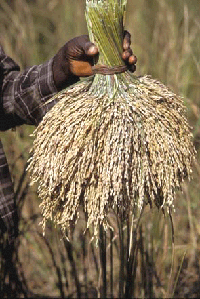 |
Traditional upland rice production | |
|
|
|
|
|
Farming in Upper Lofa County in the early 1970s was still very traditional. Each Kissi family operated its own upland farm. Farming was a way of life and the main purpose of farming was to provide the family with food: rice as the staple food, palm oil for cooking, vegetables and condiments. To obtain cash needed for the purchase of goods not found on-farm, farmers produced coffee, cocoa & sugarcane and collected palm kernels in the forest, which products were sold to the local trader, who in his turn sold these commodities to the international trading companies operating in Liberia. Traditional upland rice cultivation in the 1970s was still under shifting cultivation, with mixed cropping. Rice, the main crop was intercropped with vegetables, fruits and cotton. During the second half of the dry season the farmer selected a parcel of forest from the area to which he and his family clan had traditional land use rights. This parcel of land was cleared from under-brush and the remains were burned by a controlled fire. Large trees were kept standing to provide shade. Farmers were very careful when burning their upland farms to avoid fire spreading to other parts of the forest, not selected for that specific yearís upland farm. Most of the forest land adjacent to the plot, which had been cleared for this yearís upland rice farm, was land which had been farmed before and was presently regenerating, to restore soil fertility for upland farming in future years. Concerning soil fertility management and soil erosion, the team found very
little effects of soil erosion, even on land with slopes of up to 45 degree.
This, in spite of the fact, that much of the soil was directly exposed to open sunlight during a few months, from the time the land was cleaned till the
first month after planting, when crops and weeds again covered the soil
completely.
|
Slideshow upland rice production
The rural economy tekst |
|
|
Charles van Santen December 2005 |
||